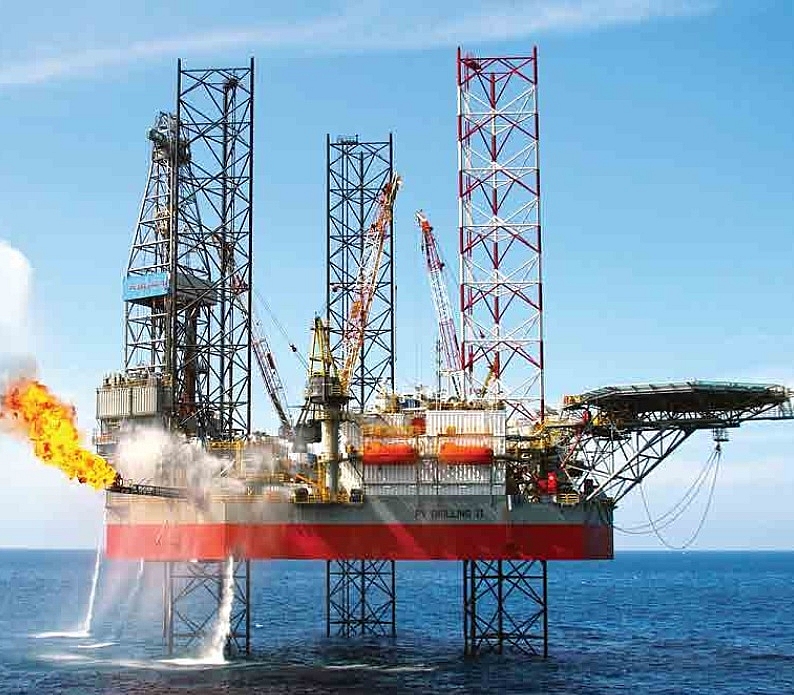Celebrating 45 years of PetroVietnam development
 |
| Celebrating 45 years of PetroVietnam development |
In its journey to become one of the leading economic groups of the country, PetroVietnam has passed many significant milestones. The first milestone was on September 3, 1975 when Vietnam Oil and Gas General Department (formerly Vietnam Oil and Gas Department) was founded by Government Council Decision No.170/CP to act as a state-owned official organisation to explore, produce, and process oil and gas, from both onshore and offshore fields in Vietnam. Six years later, the first gas exploitation took place from a Miocene deposit at Tien Hung formation through Well 6 in the Tien Hai C gas field with a rate of 100,000 cubic metres a day and was delivered to the gas turbine generator of a 10MW power plant.
This achievement, for the first time ever, put Vietnam on the global oil and gas map, raising the opportunity for the exploration and exploitation of an energy source and creating a good foundation for the development of Vietnam’s oil and gas sector.
In 1984, the first industrial oil well in the Bach Ho (White Tiger) field was constructed. Subsequent oil discoveries in the Rong (Dragon) field in 1985 and in the Dai Hung (Big Bear) field in 1988 confirmed that Vietnam had significant hydrocarbon deposits and propelled the industry into a new era of development. Also in the mid-80s, the first batch of crude oil from the White Tiger field was successfully exploited. It was ranked as one of the largest oil fields in Southeast Asia.
Over a decade later, a range of other outstanding projects were put into operation, such as Dinh Co Gas Processing Plant in 1999, Phu My Fertilizer Plant in 2004, Ca Mau 1 and 2 Power Plant and PM3-Ca Mau Pipeline in 2008, and Vung Ang 1 Thermal Power Plant in 2015. These have laid the foundations of the petrochemical industry.
Dung Quat Oil Refinery – the first petrochemical refinery in the country – was put into operation in 2011. Located in Binh Son commune of the central province of Quang Ngai, this refinery has an annual capacity of 6.5 million tonnes of crude and was a major national project to boost the downstream industry, aiming to develop the key economic region of Central Vietnam.
The project reflected the landmark development of PetroVietnam’s fully integrated business model, ranging from upstream to downstream, from exploration to production and processing, from gas to power and fertiliser and high-tech services.
The second petrochemical facility in Vietnam, Nghi Son Refinery and Petrochemical Complex commenced commercial operation in 2018. Located in Tinh Gia district, Thanh Hoa province, this complex has a total investment capital of over $9 billion and a processing capacity of 200,000 barrels of Kuwait crude oil per day (equivalent to 10 million tonnes per year) and plays a key role in Vietnam’s energy security and the socioeconomic development of the north-central region.
In addition, the leading corporation is central to accelerating economic growth, skilled human resources development, international integration, and overseas investment.
| In the first seven months of this year, while many other international oil groups were struggling with serious downturns in profit or even losses caused by the double crisis of falling oil prices and the COVID-19 pandemic, thanks to the implementation of many synchronous solutions, PetroVietnam still gained an after-tax profit of VND10 trillion ($434.7 million) and contributed more than VND38 trillion ($1.65 billion) to the state budget. |
What the stars mean:
★ Poor ★ ★ Promising ★★★ Good ★★★★ Very good ★★★★★ Exceptional
Related Contents
Latest News
More News
- Innovation to support modern healthcare development (January 07, 2026 | 10:00)
- Six localities record double-digit growth as regional performance diverges in 2025 (January 06, 2026 | 18:00)
- E-commerce market undergoes transformation amid rising competition and regulation (January 06, 2026 | 17:54)
- Vietnam’s industrial output hits seven-year high in 2025 (January 06, 2026 | 17:47)
- GELEX’s credit rating outlook upgraded to 'Positive' by VIS Rating (January 06, 2026 | 16:49)
- Finance sector lays firm groundwork for 2026 after major reform (January 06, 2026 | 15:30)
- Vietnam’s seafood exports surpass $11 billion in 2025 (January 06, 2026 | 08:51)
- Vietnam GDP posts second-strongest growth since 2011 (January 06, 2026 | 08:35)
- Double-digit GDP growth within reach with shift to higher-value expansion (January 06, 2026 | 08:33)
- Takeda Vietnam awarded for ongoing support of Vietnam’s sustainability efforts (December 31, 2025 | 21:00)

 Tag:
Tag:




















 Mobile Version
Mobile Version